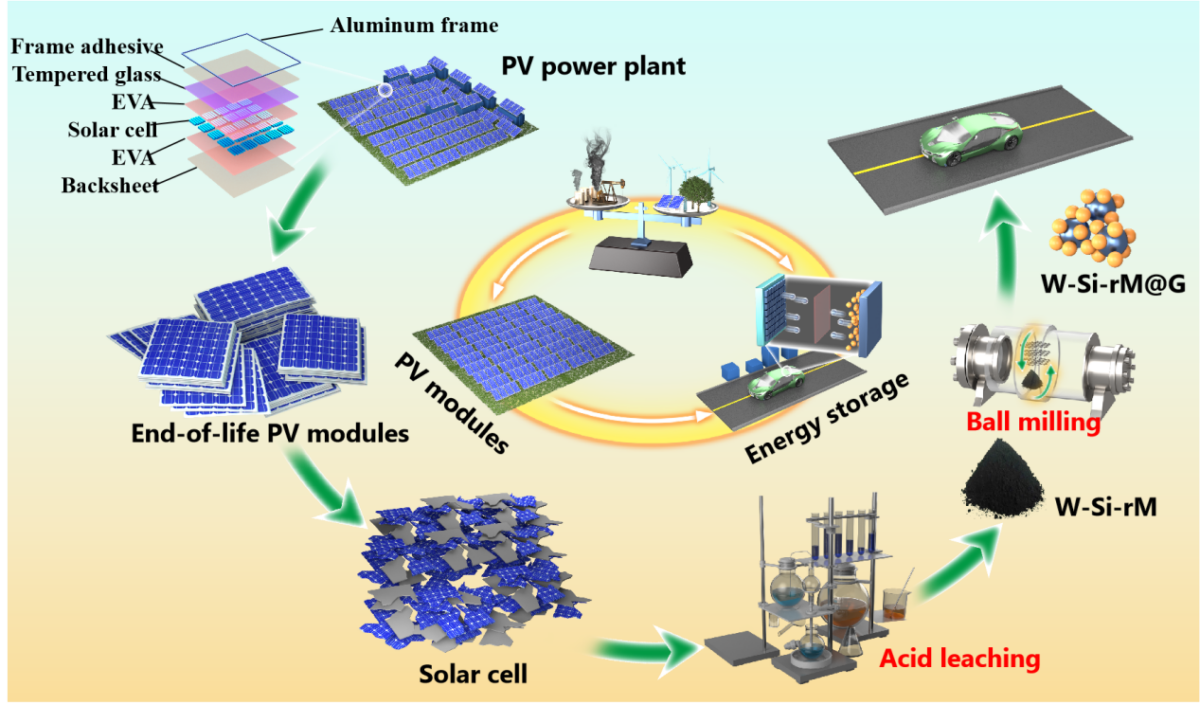Scientists led by the Kunming University of Science and Technology in China have proposed to reuse silicon from discarded solar cells to develop silicon-carbon composite anode materials that could be used in battery anodes.
“The purpose of our work was to propose a simple and effective recycling method aimed to realize the value-added reuse of silicon materials in end-of-life PV modules,” the research's lead author, Shaoyuan Li, told pv magazine. “According to current conventional technical methods such as acid and alkali leaching, a tonne of end-of-life PV modules can recover 40 kg silicon material, which can generate a net income of $104.9. If the recycled silicon material is combined with graphite using a simple ball milling process to obtain a silicon-carbon composite anode, it can generate a revenue of $1,883.”
In the study “High-performance silicon carbon anodes based on value-added recycling strategy of end-of-life photovoltaic modules,” published in Energy, the researchers explained that the waste silicon powder (W–Si) needed for the battery anodes was obtained by pulverizing solar cell fragments with a vibration mill.
The cells had been previously mechanically dismantled from the modules and then cut into 6 mm x 6 mm fragments. These fragments were then soaked in a toluene solution for 24 h to dissolve the ethylene vinyl acetate (EVA) encapsulant. “To further remove EVA, the EVA-wrapped cell fragments were placed in a tube furnace for pyrolysis at 550 C for 2 h under the argon atmosphere,” they said. ” Deionized water and ethanol were used for ultrasonic cleaning several times to obtain solar cell fragments.”
With these fragments, the research group developed the waste silicon powder by combining the recycled silicon with graphite using a simple ball milling process. The resulting composite material, called W-Si-rM@G, reportedly showed remarkable electrochemical performance.
“It had an initial discharge capacity of up to 1,770 mA h g-1, maintained a good specific capacity of 913 mA h g-1 after 200 cycles at a current density of 500 mA g-1, and the average Coulombic efficiency reached 98.99%, which was only a 0.24% capacity loss,” Li explained, noting that the use of graphite created a buffer space for the volume expansion of silicon, which enhanced the cycling stability of the material. “Graphite had good contact with silicon particles, and the introduction of graphite greatly enhanced the electrical conductivity of the silicon material.”
Looking forward, the scientists said additional work is needed to build up a full and efficient value-added recycling industry for end-of-life PV modules, stressing the current difficulties of setting up profitable businesses in this sector without public support. “The recycling of end-of-life PV modules has certain economic feasibility, but it is not economical enough to maintain the smooth operation of an enterprise,” they stated.
This content is protected by copyright and may not be reused. If you want to cooperate with us and would like to reuse some of our content, please contact: editors@pv-magazine.com.




3 comments
By submitting this form you agree to pv magazine using your data for the purposes of publishing your comment.
Your personal data will only be disclosed or otherwise transmitted to third parties for the purposes of spam filtering or if this is necessary for technical maintenance of the website. Any other transfer to third parties will not take place unless this is justified on the basis of applicable data protection regulations or if pv magazine is legally obliged to do so.
You may revoke this consent at any time with effect for the future, in which case your personal data will be deleted immediately. Otherwise, your data will be deleted if pv magazine has processed your request or the purpose of data storage is fulfilled.
Further information on data privacy can be found in our Data Protection Policy.